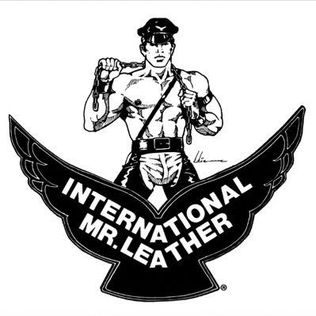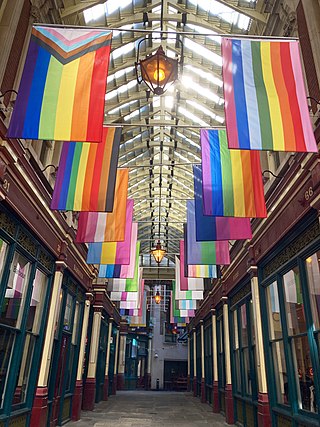
A rainbow flag is a multicolored flag consisting of the colors of the rainbow. The designs differ, but many of the colors are based on the seven spectral colors of the visible light spectrum.

The handkerchief code is a system of color-coded cloth handkerchief or bandanas for non-verbally communicating one's interests in sexual activities and fetishes. The color of the handkerchief identifies a particular activity, and the pocket it is worn in identifies the wearer's preferred role in that activity. Wearing a handkerchief on the left side of the body typically indicates one is a "top" while wearing it on the right side of the body would indicate one is a "bottom". For example, a dark blue handkerchief indicates an interest in anal sex, and wearing it in the left pocket indicates a preference for being the penetrating partner. The code was first used in the 1970s in the United States, Canada, Australia, and Europe, by gay and bisexual men seeking casual sex or BDSM practitioners. Over time the colors and types of apparel in use have greatly proliferated.

Leather subculture denotes practices and styles of dress organized around sexual activities that involve leather garments, such as leather jackets, vests, boots, chaps, harnesses, or other items. Wearing leather garments is one way that participants in this culture self-consciously distinguish themselves from mainstream sexual cultures. Many participants associate leather culture with BDSM practices and its many subcultures. For some, black leather clothing is an erotic fashion that expresses heightened masculinity or the appropriation of sexual power; love of motorcycles, motorcycle clubs and independence; and/or engagement in sexual kink or leather fetishism.

The bisexual flag, also called the bisexual pride flag, is a pride flag representing bisexuality, bisexual individuals and the bisexual community. According to Michael Page, the designer of the flag, the pink stripe represents attraction to the same sex, while the blue stripe represents attraction to the opposite sex. The purple stripe, the resulting "overlap" of the blue and pink stripes, represents attraction to both sexes.

Folsom Street Fair (FSF) is an annual BDSM and leather subculture street fair, held in September that concludes San Francisco's "Leather Pride Week". The Folsom Street Fair, sometimes referred to simply as "Folsom", takes place on the last Sunday in September, on Folsom Street between 8th and 13th Streets, in San Francisco's South of Market district.

The Society of Janus is the second BDSM organization founded in the United States and is a San Francisco, California-based BDSM education and support group.

The Leather Archives & Museum (LA&M) is a community archives, library, and museum located in the Rogers Park neighborhood of Chicago, Illinois. Founded by Chuck Renslow and Tony DeBlase in 1991, its mission is making “leather, kink, BDSM, and fetish accessible through research, preservation, education and community engagement." Renslow and DeBlase founded the museum in response to the AIDS crisis, during which the leather and fetish communities' history and belongings were frequently lost or intentionally suppressed and discarded.

International Mr. Leather(IML) is a multi-day conference and competition celebrating the leather, kink, fetish, and BDSM communities. Established in 1979, IML is held annually in Chicago over Memorial Day weekend, drawing thousands of contestants and spectators from around the world. As of 2024, 27 countries spanning six continents have competed.

A pride flag is any flag that represents a segment or part of the LGBTQ community. Pride in this case refers to the notion of LGBTQ pride. The terms LGBTQ flag and queer flag are often used interchangeably.
Over the course of its history, the LGBTQ community has adopted certain symbols for self-identification to demonstrate unity, pride, shared values, and allegiance to one another. These symbols communicate ideas, concepts, and identity both within their communities and to mainstream culture. The two symbols most recognized internationally are the pink triangle and the rainbow flag.

The rainbow flag or pride flag is a symbol of LGBTQ pride and LGBTQ social movements. The colors reflect the diversity of the LGBTQ community and the spectrum of human sexuality and gender. Using a rainbow flag as a symbol of LGBTQ pride began in San Francisco, California, but eventually became common at LGBTQ rights events worldwide.

National Leather Association International (NLA-I) is a BDSM organization, based in the United States with chapters in various cities in the United States and Canada. It was founded in 1986 as the "National Leather Association" (NLA), as a national integrated organization including gay leathermen, kinky heterosexuals and bisexuals, SM lesbians and transgender sadomasochists, and representing their interests in the face of prosecutions. Adding "International" to its name in 1991, the organization staged "Living in Leather" gatherings until 2002. After a period of decline around the turn of the millennium, NLA-I has become more active again and runs a series of awards for fiction and non-fiction writing. NLA-I's records can be found at the Leather Archives and Museum.

Kink.com is an independent San Francisco-based bondage internet pornography company that runs a group of websites devoted to BDSM and related fetishes. Kink.com, along with Kink Studios, LLC, Hogtied.com and Behindkink.com are DBAs for Cybernet Entertainment LLC, the parent company that operates the studio.

Gilbert Baker was an American artist, designer, activist, and vexillographer, best known as the creator of the rainbow flag.

Guy Baldwin is an American psychotherapist, author, activist, and educator specializing in issues of particular relevance to the BDSM and leather communities. Based in Los Angeles, he maintains that inclusion of non-injurious elements of sadomasochism in a consenting sexuality does not itself indicate or confirm mental illness or psycho-sexual dysfunction.

Bill Schmeling, better known by his pen name The Hun, was an American artist active in the late twentieth and early twenty-first century, known for his explicit, homoerotic fetish illustrations and comics.

Charles "Chuck" Renslow was an American businessman, known for pioneering homoerotic male photography in the mid-20th-century US, and establishing many landmarks of late-20th-century gay culture and leather culture, especially in the Chicago area. His accomplishments included the cofounding with Tony DeBlase of the Leather Archives and Museum, the co-founding with Dom Orejudos of the Gold Coast bar, Man's Country bathhouse, and the International Mr. Leather competition, and the founding by himself alone of Chicago's August White Party, and the magazines Triumph, Rawhide, and Mars. He was a romantic partner of Dom Orejudos as well as Chuck Arnett, Samuel Steward, David Grooms, and Ron Ehemann.

Tony DeBlase (1942–2000), also known as Anthony DeBlase, was part of the BDSM and leather subcultures. He was the designer of the leather pride flag.
Bootblacks take care of the boots, and garments such as leather jackets, vests, chaps, harnesses, as well as other gear of Leatherpeople and the BDSM community. With the establishment of local, regional and international bootblack contests in the 1990s and early 2000s, bootblacks have gained visibility as a subculture in their own right. Nowadays, bootblack stands as well as classes on bootblacking are common fixtures at events, contests, conferences and parties. Bootblacks are not only preserving the physical items but are also collecting the stories of their wearers. Therefore, bootblacks play a central role in the oral history of the leather scene. While outsiders often link bootblacking to service-oriented submission, Bootblacks might take on any role in a BDSM dynamic.
Various pride flags have been used to symbolize gay men. Rainbow flags have been used since 1978 to represent both gay men and, subsequently, the LGBT community as a whole. Since the 2010s, various designs have been proposed to specifically represent the gay male community.
























